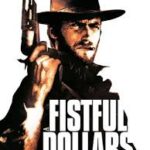Meet Sergio Leone (2): The Good, the Bad, and the Ugly
By the time The Good, the Bad, and the Ugly was released in 1966, Sergio Leone had already established himself as a trailblazer in the Western genre with A Fistful of Dollars and For a Few Dollars More. However, it was this third installment of the Dollars Trilogy that would cement his legacy as one of the greatest directors in cinematic history. Often hailed as the ultimate Spaghetti Western, The Good, the Bad, and the Ugly is a masterpiece that combines Leone’s innovative visual style, Ennio Morricone’s unforgettable music, and a trio of iconic performances to create a film that has transcended its genre and become a cultural touchstone.
Set against the backdrop of the American Civil War, The Good, the Bad, and the Ugly follows the intertwined fates of three men—Blondie (the Good), Angel Eyes (the Bad), and Tuco (the Ugly)—as they compete to find a hidden cache of Confederate gold. The film’s narrative is as much a treasure hunt as it is a study in character contrasts, with each of the three main characters embodying different aspects of humanity’s moral spectrum.
Blondie, played by Clint Eastwood, is a laconic gunslinger who, while ruthless, follows his own code of ethics. Angel Eyes, portrayed by Lee Van Cleef, is a cold-blooded, merciless killer who will stop at nothing to achieve his goals. Eli Wallach’s Tuco, the most complex of the trio, is a crafty, resourceful bandit who oscillates between humor and cruelty, evoking both sympathy and disdain from the audience. Their journeys are marked by betrayals, shifting alliances, and moments of unexpected camaraderie, all leading to the film’s legendary three-way standoff.
One of the key strengths of The Good, the Bad, and the Ugly lies in its richly developed characters, each representing a distinct moral archetype. Clint Eastwood’s Blondie is the quintessential anti-hero—stoic, calculating, and driven by self-interest, yet capable of occasional acts of compassion. Eastwood’s performance is defined by his minimalist acting style, where subtle facial expressions and body language convey a depth of emotion and intent that dialogue often does not.
Lee Van Cleef’s Angel Eyes, on the other hand, embodies pure malevolence. His character is a study in cold, methodical evil, driven by greed and a complete lack of conscience. Van Cleef’s piercing gaze and menacing demeanor make Angel Eyes one of the most memorable villains in Western cinema, a figure who exudes menace with every calculated move.
Eli Wallach’s Tuco is the film’s wild card—a character full of contradictions. Tuco’s wit and resourcefulness make him a survivor, but his volatile nature and tendency to betray those around him make him unpredictable. Wallach brings a nuanced performance to Tuco, infusing the character with a mix of humor, pathos, and ruthlessness. His interactions with Blondie, in particular, form the emotional core of the film, adding layers of complexity to their partnership/rivalry.
No discussion of The Good, the Bad, and the Ugly would be complete without mentioning Ennio Morricone’s iconic score. The film’s main theme, characterized by its haunting, whistling melody, has become synonymous with the Western genre itself. Morricone’s use of unconventional instruments and sounds, such as gunshots and whip cracks, creates an auditory landscape that is as evocative as Leone’s visuals. The score not only enhances the film’s atmosphere but also acts as a narrative device, underscoring the tension and emotion in key scenes.
One of the most memorable uses of Morricone’s music is during the final showdown at the cemetery. As Blondie, Tuco, and Angel Eyes face off in a deadly Mexican standoff, Morricone’s “The Ecstasy of Gold” builds to a crescendo, amplifying the tension to almost unbearable levels. The music, combined with Leone’s masterful editing and shot composition, makes this sequence one of the most iconic in cinema history.
Leone’s visual storytelling in The Good, the Bad, and the Ugly is nothing short of revolutionary. His use of extreme close-ups, long shots, and innovative camera angles creates a visual language that is both dynamic and expressive. The film’s wide, sweeping shots of desolate landscapes juxtaposed with tight close-ups of the characters’ faces emphasize the isolation and tension inherent in the story.
Leone’s pacing is deliberate, allowing scenes to unfold with a slow, almost meditative rhythm that builds anticipation. This approach is particularly evident in the film’s climactic scenes, where the tension is drawn out to its breaking point before erupting into explosive action. The use of silence and stillness in these moments is as powerful as the violence that follows, creating a cinematic experience that is as much about the anticipation of conflict as the conflict itself.
The Good, the Bad, and the Ugly is more than just a Western; it is a defining moment in the history of cinema. Sergio Leone’s direction, combined with the performances of Eastwood, Van Cleef, and Wallach, as well as Morricone’s unforgettable score, created a film that transcends its genre and continues to influence filmmakers and audiences alike. The film’s exploration of moral ambiguity, its innovative visual style, and its masterful use of music and atmosphere make it a timeless classic. As the crowning achievement of the Dollars Trilogy, The Good, the Bad, and the Ugly remains a towering example of what cinema can achieve when art and storytelling come together in perfect harmony.



phnicecasino
Bro, Phnicecasino is where the action’s at. They have a solid selection of games and the site’s easy to navigate. Definitely worth a look at phnicecasino.